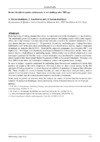Identificador persistente para citar o vincular este elemento:
https://accedacris.ulpgc.es/jspui/handle/10553/114784
| Título: | Booster biocides in marine environment. A new challenge after TBT age | Autores/as: | Sánchez Rodríguez, A. Sosa Ferrera, María Zoraida Santana Rodríguez, José Juan |
Clasificación UNESCO: | 251001 Oceanografía biológica 251002 Oceanografía química 331912 Construcción naval 330811 Control de la contaminación del agua |
Fecha de publicación: | 2014 | Conferencia: | IV Congress of Marine Sciences | Resumen: | From beginning of sailing, humans have faced an important issue in the development of naval activity. The undesirable growth of organisms on submerged surfaces (biofouling) carries with it some negative effects, including increased fuel consumption and corrosion, as well as the potential introduction of foreign species into new ecosystems. To prevent its occurrence, antifouling paint coatings have been traditionally used. In the past, these antifouling paints were based on lead, arsenic, organic compounds of mercury or pesticides like DDT. From the70s, organotin compounds like tributyltin (TBT) and triphenyltin (TPT) began to be extensively used in paint formulations with excellent results. These compounds showed a high efficacy as antifouling agents. Unfortunately, they exhibited a high toxicity over non-target organisms. For this reason, several restrictions were introduced by countries and international organisms like International Marine Organization (IMO) or European Community. Nowadays and from 2008 it is not allow sail in European community waters with organotin based coatings. In order to replace organotin compounds in antifouling paint formulations, manufactures based their products on cooper as the active component. However, it does not show a toxic activity for the full spectrum of fouling organisms, so others biocides are added to formulations to improve their efficacies. These biocides are known as booster biocides and some of them have been previously used in agriculture or industrial activities. Nonetheless, when they began to be used as antifouling paints, there were not available data about their possible impacts over marine environment. In this study we present an overview about the analysis and control of booster biocides in marine environment. Analytical methodologies, levels and toxicity effects of booster biocides will be reviewed. | URI: | https://accedacris.ulpgc.es/handle/10553/114784 | ISBN: | 84-697-0471-0 | Fuente: | Book of Abstracts submitted to the IV Congress of Marine Sciences. Las Palmas de Gran Canaria, June 11th to 13th 2014, p. 127 |
| Colección: | Actas de congresos |
Visitas
27
actualizado el 15-abr-2023
Descargas
3
actualizado el 15-abr-2023
Google ScholarTM
Verifica
Altmetric
Comparte
Exporta metadatos
Los elementos en ULPGC accedaCRIS están protegidos por derechos de autor con todos los derechos reservados, a menos que se indique lo contrario.
